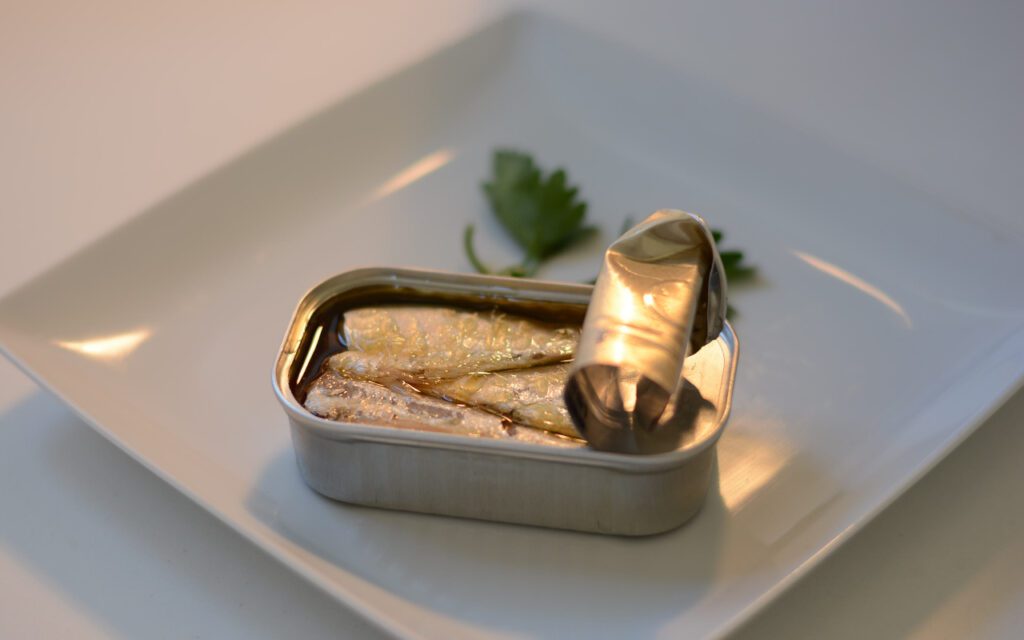Learning what your Diabetic dog can and can not eat is very important.
Basically, when feeding a diabetic dog, you have to make sure that the foods are not increasing their sugar levels fast.
For this, we search foods with a low glycemic index.
Meaning, these foods digest slowly and do not raise blood sugar.
Sardines are one of these foods that are actually great for diabetic dogs.
Read on to find out more about sardines and the benefits they have for diabetic dogs.
Can Diabetic Dogs Eat Sardines
Can Diabetic Dogs Eat Sardines

Yes, diabetic dogs can eat sardines. In fact, they are a great source of healthy protein and essential fatty acids that can help to maintain good glucose levels in diabetic dogs.
Sardines are also high in omega-3 fatty acids which have anti-inflammatory properties that can be beneficial for both type 1 and type 2 diabetes.
They are also rich in vitamins such as vitamins A and D, minerals like calcium, zinc, iron, and magnesium, and other essential nutrients including selenium and phosphorus.
When feeding your diabetic dog sardines it is important to make sure you buy the right kind. Wild-caught sardines are preferable over farmed because they contain higher levels of nutrients than farmed fish.
You should also look out for sardines that are canned in water or olive oil and avoid those packed in sunflower or other vegetable oils.
Can Diabetic Dogs Eat Sardines
How Many Sardines Can Diabetic Dogs Eat

As a general rule of thumb, it is best to restrict sardine intake to no more than one sardine per 10 pounds (4.5 kg) of body weight per day.
It is important to be mindful of portion size when feeding diabetic dogs sardines.
Diabetic dogs need to be carefully monitored when it comes to their diet. While sardines can provide a source of nutritional benefits, they should be fed in moderation due to their high fat and salt content.
The ideal amount of sardines for diabetic dogs depends on the specific size, age, activity level, and overall health of the dog.
Portion size should never exceed 10-15% of your dog’s daily caloric intake, so if you are unsure about the right amount for your dog talk to your veterinarian for advice.
Additionally, make sure you check with your vet before introducing any new food into your dog’s diet as they can offer further advice on how to feed these foods safely and healthily.
Can Diabetic Dogs Eat Sardines
Health Benefits of Sardines For Diabetic Dogs
- Improved Blood Sugar Regulation: Sardines are a lean and low-carbohydrate source of protein, which makes them beneficial for controlling the blood sugar levels of diabetic dogs. The Omega-3 fatty acids found in sardines can also help improve insulin sensitivity and reduce inflammation, both of which may be helpful for keeping your pooch’s glucose levels in check.
- Heart Health: The omega-3 fatty acids in sardines have been shown to have a positive effect on heart health by reducing triglyceride levels, improving blood pressure, and reducing plaque buildup in the arteries. This is important for pets with diabetes since they are at a higher risk of developing cardiovascular disease.
- Eye Health: Diabetic dogs are more prone to developing eye health problems, such as glaucoma and cataracts. Thankfully, sardines contain high amounts of vitamin A, which can help slow the development of these conditions.
- Strong Bones: Sardines are packed with calcium and phosphorus, both of which help keep your pup’s bones strong and healthy. This is important for diabetic dogs since they may be at a higher risk of bone-related issues due to their condition.
- Balanced Diet: Including sardines in your pup’s diet can also help ensure that he or she is getting the right balance of nutrients for optimal health. The omega-3 fatty acids present in sardines can also help support proper brain and nerve functions.
Can Diabetic Dogs Eat Sardines
How To Prepare Sardines For Diabetic Dogs
- Boiled Sardines: Boil sardines in water for about 10 minutes. This method preserves the nutritional value of the fish and makes it easier to digest for diabetic dogs.
- Baked Sardines: Place sardines on a baking tray lined with parchment paper and bake at 350°F (176°C) for 15-20 minutes. This will keep most of the nutrients intact and is an easy way to prepare sardines for your pup.
- Steamed Sardines: To steam, place sardines in a covered pot with a small amount of liquid over low heat until they are cooked through—about 5 minutes or so depending on the size and thickness of the fillets. This will help preserve the nutrients in the fish while making it easier to digest for your pup.
Can Diabetic Dogs Eat Sardines
What Canned Sardines Are Best For Dogs?
When considering canned sardines for your dog, you should look for those that are packed in water or oil and have no added ingredients.
Make sure to check the label to ensure there are no artificial flavors, preservatives, or other unhealthy additives.
Also, ensure that the fish is sustainably caught – this can be found on the packaging as well. Be aware of any bones present in the sardines; these can be a choking hazard for dogs and should be avoided if possible.
You may also want to consider purchasing smaller cans of sardines so that your pup doesn’t get too much at once. After all, moderation is key when it comes to feeding your fur baby!
For added health benefits, try adding some freshly chopped vegetables and fruit to the canned sardines.
This will provide a balanced meal for your pup and enhance their overall health. You may also want to consider adding healthy supplements such as fish oil or glucosamine for joint health.
Finally, always ensure that you are following your veterinarian’s advice when it comes to incorporating any new food into your dog’s diet.
This is especially important if your pup has any existing dietary restrictions or sensitivities. With these tips in mind, you can make sure that your furry friend gets the best nutrition from their diet!
Can Diabetic Dogs Eat Sardines
Is There Sugar in Canned Sardines?
Yes, some canned sardines do contain sugar. These are usually the sardines that have been packed in a sauce or marinade, such as tomato sauce, olive oil, and lemon juice.
The added sugars can come from either natural sources like honey or maple syrup, or they can be added as refined sugar.
It’s best to check the label of the particular brand you are buying to determine if there is added sugar in the product.
If so, you can opt for ones that don’t contain added sugar or look for low-sugar options.
Also, it’s important to note that most of the sodium content in canned sardines comes from their brine and not from any additional ingredients like sugars.
In Conclusion
Diabetic dogs can safely eat sardines as a part of their balanced diet.
Just make sure that the sardines do not contain any artificial flavors, sugar, or seasonings that are toxic for dogs.





Leave a Reply